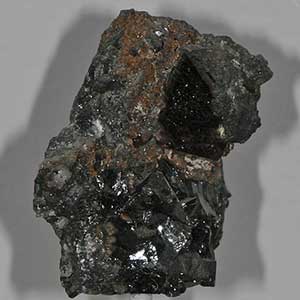 |
| Stottite - FeGe(OH)6. |
Germanium is a metallic-looking, grayish-white element. Despite its metallic appearance, it is not considered a metal, but a metalloid. This means that in some ways it is like a metal (for instance, its metallic appearance) but in other significant ways it is more like a non-metal (for instance, it is not as good a conductor of electricity as true metals are). Its atomic number is 32 and its symbol is Ge.
Germanium was discovered in 1886 by the German chemist Clemens A. Winkler. Winkler discovered germanium in the mineral argyrodite. However, germanium rarely forms distinct minerals. The existence of germanium was predicted in 1871 by the chemist Mendeleev. He predicted this new element would have properties very similar to silicon. His predictions ultimately proved to be very accurate.
Germanium is not necessary to human health; however, its presence in the body does stimulate metabolism. In addition, studies indicate it also plays a role in the function of the immune system.
Name
Clemens Winkler named germanium from the Latin word Germania meaning Germany.
Sources
Germanium was first discovered and isolated from a specimen of the mineral argyrodite. However, there are no significant argyrodite deposits. Germanium is retrieved as a by-product of zinc and copper-zinc-lead ores where it is found as a trace element. Germanium also occurs in significant quantities in carbon-based materials such as coal (though not all coal contains germanium).
Two U.S. companies in New York and Oklahoma refine ore material to produce pure germanium. Worldwide, about one-fourth of the germanium consumed comes from recycled metals, particularly metals used in the manufacture of electronic and optical devices.
Of the germanium imported into the United States, almost all comes from Belgium, China, and Russia.
Uses
Germanium is a metalloid. It does conduct electricity, but not as well as true metals. Therefore, it is described as a semiconductor. Consequently, germanium is important in the electronics industry where it is used to make transistors and semiconductors. The fiber optic industry uses a large portion of the germanium consumed annually.
It is also used as a catalyst in the production of polymers. Because infrared radiation can pass through germanium, it is used in infrared equipment and applications. It is also used in some other applications, including chemotherapy for treating certain cancers.
Substitutes and Alternative Sources
Germanium has been commercially retrieved from coal ash. Coal ash might one day become a significant source of germanium.
Silicon can be used in place of germanium for many electronic applications. Silicon is also less expensive. It has been found that zinc selenide and germanium glass can be used in place of germanium in some infrared equipment; however, these substances do not work as well and germanium is much preferred.
As a catalyst in PET (polyethylene terephthalate) plastics used in beverage containers, germanium has a few substitutes. Titanium does not give as clear a plastic product. An aluminum-based catalyst is also currently being developed.